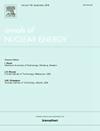采用机器学习方法对来自多种反应堆的钚样品进行源鉴别
IF 1.9
3区 工程技术
Q1 NUCLEAR SCIENCE & TECHNOLOGY
引用次数: 0
摘要
本文章由计算机程序翻译,如有差异,请以英文原文为准。
Adapting a machine learning method for the source discrimination of plutonium samples mixed from multiple reactor types
Plutonium (Pu) samples that are sourced from multiple, different reactor types present a challenge to nuclear forensics investigations. Previous studies have developed a nuclear forensics methodology capable of identifying a Pu sample’s reactor type of origin using isotope ratios as features in machine learning classification models. However, the models could only attribute Pu sourced from a single reactor type. The methodology was adapted to discriminate between Pu produced from the six original single reactor type classes and twelve new classes comprised of binary mixtures of the six original reactor type classes. This adaptation was a success, with a support vector machine (SVM) identified as the most suitable model type for the task. The model’s sensitivity to different groups of features was examined and the model was also validated with data from experimentally produced Pu samples, in both single reactor type and mixed reactor type cases.
求助全文
通过发布文献求助,成功后即可免费获取论文全文。
去求助
来源期刊

Annals of Nuclear Energy
工程技术-核科学技术
CiteScore
4.30
自引率
21.10%
发文量
632
审稿时长
7.3 months
期刊介绍:
Annals of Nuclear Energy provides an international medium for the communication of original research, ideas and developments in all areas of the field of nuclear energy science and technology. Its scope embraces nuclear fuel reserves, fuel cycles and cost, materials, processing, system and component technology (fission only), design and optimization, direct conversion of nuclear energy sources, environmental control, reactor physics, heat transfer and fluid dynamics, structural analysis, fuel management, future developments, nuclear fuel and safety, nuclear aerosol, neutron physics, computer technology (both software and hardware), risk assessment, radioactive waste disposal and reactor thermal hydraulics. Papers submitted to Annals need to demonstrate a clear link to nuclear power generation/nuclear engineering. Papers which deal with pure nuclear physics, pure health physics, imaging, or attenuation and shielding properties of concretes and various geological materials are not within the scope of the journal. Also, papers that deal with policy or economics are not within the scope of the journal.
 求助内容:
求助内容: 应助结果提醒方式:
应助结果提醒方式:


